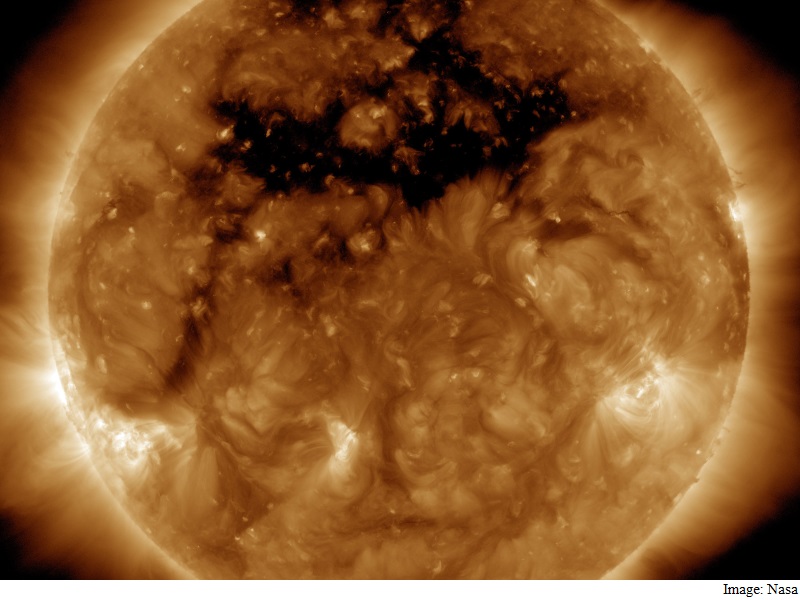- Home
- Science
- Science News
- Nasa Spacecraft Spots Giant 'Coronal Hole' in Sun
Nasa Spacecraft Spots Giant 'Coronal Hole' in Sun

The new image was taken on October 10 at an ultraviolet wavelength unseen by the human eye. The gap in the Sun's magnetic field lets out a stream of particles travelling at up to 800 kilometres per second, kindling a days-long geomagnetic storm upon hitting Earth.
Coronal holes normally form over the Sun's poles and lower latitudes, more often when the Sun is at a less active point in its 11-year cycle.
They are areas within the Sun's outermost layer, called its corona, which are lower-density and cooler - that, plus the weakened magnetic field, lets the plasma and charged particles that make up the corona stream out more easily in a solar wind, 'Space.com' reported.
If aimed toward Earth, it could result in a geomagnetic storm, a phenomenon that can affect power and navigation for satellites orbiting the Earth as well as radio communication. Another side effect of a geomagnetic storm is enhanced northern lights.
As the coronal hole continues its slow march westward on the Sun's surface (to the right, from Earth's perspective), solar winds will stay strong, National Oceanic and Atmospheric Administration's (NOAA) officials said.
Catch the latest from the Consumer Electronics Show on Gadgets 360, at our CES 2026 hub.
Related Stories
- Samsung Galaxy Unpacked 2025
- ChatGPT
- Redmi Note 14 Pro+
- iPhone 16
- Apple Vision Pro
- Oneplus 12
- OnePlus Nord CE 3 Lite 5G
- iPhone 13
- Xiaomi 14 Pro
- Oppo Find N3
- Tecno Spark Go (2023)
- Realme V30
- Best Phones Under 25000
- Samsung Galaxy S24 Series
- Cryptocurrency
- iQoo 12
- Samsung Galaxy S24 Ultra
- Giottus
- Samsung Galaxy Z Flip 5
- Apple 'Scary Fast'
- Housefull 5
- GoPro Hero 12 Black Review
- Invincible Season 2
- JioGlass
- HD Ready TV
- Laptop Under 50000
- Smartwatch Under 10000
- Latest Mobile Phones
- Compare Phones
- OPPO Reno 15 Pro Max
- Honor Win RT
- Honor Win
- Xiaomi 17 Ultra Leica Edition
- Xiaomi 17 Ultra
- Huawei Nova 15
- Huawei Nova 15 Pro
- Huawei Nova 15 Ultra
- Asus ProArt P16
- MacBook Pro 14-inch (M5, 2025)
- OPPO Pad Air 5
- Huawei MatePad 11.5 (2026)
- Xiaomi Watch 5
- Huawei Watch 10th Anniversary Edition
- Acerpure Nitro Z Series 100-inch QLED TV
- Samsung 43 Inch LED Ultra HD (4K) Smart TV (UA43UE81AFULXL)
- Asus ROG Ally
- Nintendo Switch Lite
- Haier 1.6 Ton 5 Star Inverter Split AC (HSU19G-MZAID5BN-INV)
- Haier 1.6 Ton 5 Star Inverter Split AC (HSU19G-MZAIM5BN-INV)

















